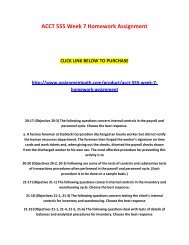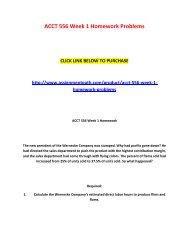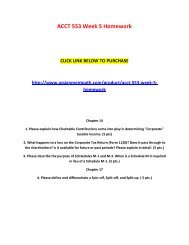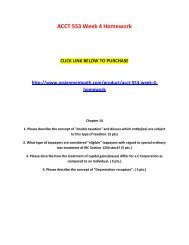ACCT 444 Week 3 Quiz
ACCT 444 Week 3 Quiz CLICK LINK BELOW TO PURCHASE http://www.assignmentpath.com/product/acct-444-week-3-quiz 1. (TCO 6) Which of the following statements regarding documentation is not correct? 2. (TCO 6) When analytical procedures reveal no unusual fluctuations, the implication is that 3. (TCO 6) The primary purpose of performing analytical procedures in the testing phase of an audit is to 4. (TCO 6) Three common types of confirmations used by auditors are (1) negative confirmations where only a response is requested if the debtor disagrees with the amount, (2) positive confirmations with a request for information where the debtor is requested to respond and to include their believed balance, and (3) positive confirmations with the information included where the debtor is requested to respond and to confirm the balance we give them. If they were placed in the order of their competence, from highest to lowest, the sequence would be 5. (TCO 7) Analytical procedures used in planning an audit should focus on identifying 6. (TCO 7) A measure of how willing the auditor is to accept that the financial statements may be materially misstated after the audit is completed and an unqualified opinion has been issued is the 7. (TCO 7) Which of the following is not correct regarding the communications between successor and predecessor auditors? 8. (TCO 8) The FASB definition of materiality emphasizes what class of financial statement users? 9. (TCO 8) Auditors are _____ to decide on the combined amount of misstatements in the financial statements that they would consider material early in the audit. 10. (TCO 8) Which of the following is not a correct statement regarding the allocation of the preliminary judgment about materiality to balance sheet accounts?
ACCT 444 Week 3 Quiz
CLICK LINK BELOW TO PURCHASE
http://www.assignmentpath.com/product/acct-444-week-3-quiz
1. (TCO 6) Which of the following statements regarding documentation is not correct?
2. (TCO 6) When analytical procedures reveal no unusual fluctuations, the implication is that
3. (TCO 6) The primary purpose of performing analytical procedures in the testing phase of an
audit is to
4. (TCO 6) Three common types of confirmations used by auditors are (1) negative
confirmations where only a response is requested if the debtor disagrees with the amount,
(2) positive confirmations with a request for information where the debtor is requested to
respond and to include their believed balance, and (3) positive confirmations with the
information included where the debtor is requested to respond and to confirm the balance
we give them. If they were placed in the order of their competence, from highest to lowest,
the sequence would be
5. (TCO 7) Analytical procedures used in planning an audit should focus on identifying
6. (TCO 7) A measure of how willing the auditor is to accept that the financial statements may
be materially misstated after the audit is completed and an unqualified opinion has been
issued is the
7. (TCO 7) Which of the following is not correct regarding the communications between
successor and predecessor auditors?
8. (TCO 8) The FASB definition of materiality emphasizes what class of financial statement
users?
9. (TCO 8) Auditors are _____ to decide on the combined amount of misstatements in the
financial statements that they would consider material early in the audit.
10. (TCO 8) Which of the following is not a correct statement regarding the allocation of the
preliminary judgment about materiality to balance sheet accounts?
Create successful ePaper yourself
Turn your PDF publications into a flip-book with our unique Google optimized e-Paper software.
<strong>ACCT</strong> <strong>444</strong> <strong>Week</strong> 3 <strong>Quiz</strong><br />
CLICK LINK BELOW TO PURCHASE<br />
http://www.assignmentpath.com/product/acct-<strong>444</strong>-week-3-quiz<br />
1. (TCO 6) Which of the following statements regarding documentation is not correct?<br />
2. (TCO 6) When analytical procedures reveal no unusual fluctuations, the implication is that<br />
3. (TCO 6) The primary purpose of performing analytical procedures in the testing phase of an<br />
audit is to<br />
4. (TCO 6) Three common types of confirmations used by auditors are (1) negative<br />
confirmations where only a response is requested if the debtor disagrees with the amount,<br />
(2) positive confirmations with a request for information where the debtor is requested to<br />
respond and to include their believed balance, and (3) positive confirmations with the<br />
information included where the debtor is requested to respond and to confirm the balance<br />
we give them. If they were placed in the order of their competence, from highest to lowest,<br />
the sequence would be<br />
5. (TCO 7) Analytical procedures used in planning an audit should focus on identifying<br />
6. (TCO 7) A measure of how willing the auditor is to accept that the financial statements may<br />
be materially misstated after the audit is completed and an unqualified opinion has been<br />
issued is the<br />
7. (TCO 7) Which of the following is not correct regarding the communications between<br />
successor and predecessor auditors?<br />
8. (TCO 8) The FASB definition of materiality emphasizes what class of financial statement<br />
users?
9. (TCO 8) Auditors are _____ to decide on the combined amount of misstatements in the<br />
financial statements that they would consider material early in the audit.<br />
10. (TCO 8) Which of the following is not a correct statement regarding the allocation of the<br />
preliminary judgment about materiality to balance sheet accounts?

















